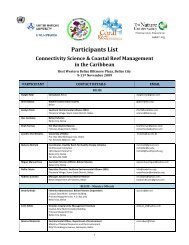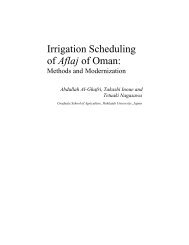The Global Water Crisis: Addressing an Urgent Security - Unu-inweh ...
The Global Water Crisis: Addressing an Urgent Security - Unu-inweh ...
The Global Water Crisis: Addressing an Urgent Security - Unu-inweh ...
You also want an ePaper? Increase the reach of your titles
YUMPU automatically turns print PDFs into web optimized ePapers that Google loves.
Introduction<br />
Despite being a water-abund<strong>an</strong>t country, Afgh<strong>an</strong>ist<strong>an</strong> still struggles to make the best of its natural resources <strong>an</strong>d to achieve<br />
water security for its citizens. A reform of the water sector was initiated as early as 2002, yet the ‘good govern<strong>an</strong>ce’<br />
principles, enshrined in the recently passed <strong>Water</strong> Law of 2009 (Islamic Republic of Afgh<strong>an</strong>ist<strong>an</strong>, 2009) <strong>an</strong>d the <strong>Water</strong> Sector<br />
Strategy (Islamic Republic of Afgh<strong>an</strong>ist<strong>an</strong>, 2008), have yet to demonstrate results on the ground. More noteworthy, early<br />
signs of a lack of buy-in for a new model of govern<strong>an</strong>ce introduced by the international community are now emerging.<br />
In fact, while a drive towards a more infrastructure- <strong>an</strong>d technically-oriented development is seemingly prioritized by<br />
the government, this paper argues that in Afgh<strong>an</strong>ist<strong>an</strong>, a choice c<strong>an</strong>not be made between developing infrastructure or<br />
better govern<strong>an</strong>ce <strong>an</strong>d m<strong>an</strong>agement: it is about developing both in <strong>an</strong> integrated way. Additionally, in order to improve<br />
govern<strong>an</strong>ce, it is now necessary to take <strong>an</strong> adaptive approach to adapt <strong>an</strong>d fine-tune imported models in order to better<br />
fit the realities on the ground, <strong>an</strong>d to build on already existing water m<strong>an</strong>agement institutions.<br />
1. Salient Figures of <strong>Water</strong> Insecurity<br />
1.1. Failing to meet essential needs: safe drinking water<br />
Afgh<strong>an</strong>ist<strong>an</strong> is among the countries with the lowest accessibility to safe drinking water sources <strong>an</strong>d hygienic s<strong>an</strong>itation.<br />
Despite massive interventions by the international community – US $19 billion has been spent by the U.S. alone, the<br />
largest donor of Afgh<strong>an</strong>ist<strong>an</strong>’s reconstruction (Christi<strong>an</strong> Science Monitor, 2011) – the most recent national survey shows<br />
that only 27% of the population has access to protected water sources, while only 5% has access to improved s<strong>an</strong>itation<br />
(MRRD <strong>an</strong>d CSO, 2009). Furthermore, the current trend of progress at 1% per year indicates that Afgh<strong>an</strong>ist<strong>an</strong> will be<br />
delayed in meeting its water targets of the Millennium Development Goals (MDG) of reducing the number of the Afgh<strong>an</strong><br />
population without access to safe drinking water by half by 2020, by more th<strong>an</strong> 20 years (Figure 1). As a result, every<br />
hour, six children under the age of five die because of the effects of diarrhea (CPHD, 2011).<br />
Improved drinking water coverage (%)<br />
2045<br />
2040<br />
2035<br />
2030<br />
2025<br />
2020<br />
2015<br />
2010<br />
2005<br />
2000<br />
0 10 20 30 40 50 60 70 80 90<br />
Coverage rate<br />
Source: Calculated based on MRRD <strong>an</strong>d CSO (2007, 2009).<br />
Figure 1. <strong>The</strong> projected trend for meeting the MDG target for access to safe drinking water in Afgh<strong>an</strong>ist<strong>an</strong> (CPHD, 2011).<br />
<strong>Water</strong> Govern<strong>an</strong>ce Reform in Afgh<strong>an</strong>ist<strong>an</strong>: Early Lessons for a <strong>Water</strong>-secure Future<br />
Part 2<br />
111




